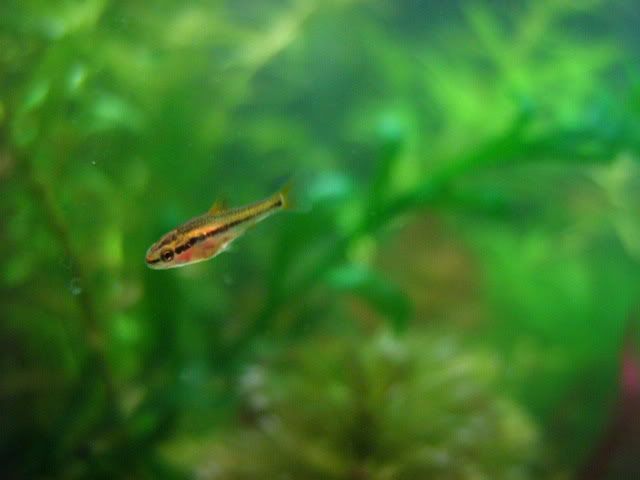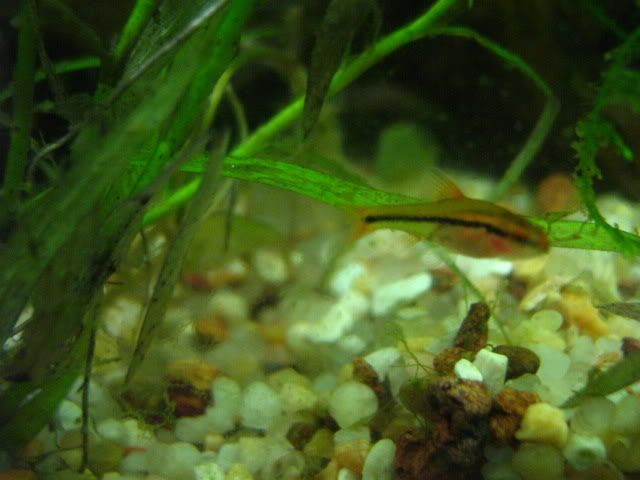sinistral
Fish Addict
Common name: Cherry Barb
Scientific name: Barbus titteya (formerly Puntius titteya)
Origin: Sri Lanka.
Family: Cyprinidae
Maximum size: 1.5 to 2 inches (3.8 to 5.1cm)
Care: A peaceful, active small fish, the cherry barb is hardy enough to cycle new tanks. They do well in the community freshwater tropical tank, as they are less nippy than other barbs. Happiest in groups of at least 6 (though they only shoal loosely), they may also be kept in a ratio of 1 male for every 2 females (some sources suggest that a male/female pair might also do well). They tend to occupy the bottom and middle strata of the aquarium. A moderately to densely planted tank with some shade will help these rather shy fish feel more comfortable, as well as set off their colors.
They are adaptable to a range of water conditions, and require tropical temperatures (73-81F or 23-27C). A minimum recommended tank size is 10g. Their life expectancy is as long as 5 years.
Feeding: These fish are not fussy (they are omnivores), and will accept a broad range of foods, including flake, frozen, live, and fresh vegetables.
Sexing: In terms of coloration, females are a tan/light pink with black lines. Males are slimmer bodied, and are a darker red with black lines (see pictures below). Before breeding, males will turn a very rich shade of red. In the store, males and females might sometimes be confused if conditions are stressful (males will turn pale, as will most fish under stress).
Breeding: Use of a breeding tank is helpful. Ideal water conditions for breeding consist of a well-planted tank with soft water and a pH of 6-6.5. Cherry barbs are egg-scatterers and will lay between 200-500 eggs at a time (most sources suggest 300 is the maximum). The parents should be removed if possible, as they do tend to eat the eggs. Fry will hatch in 24-48 hours and will be free-swimming within a week.
Comments: I have 3 lovely cherry barbs in a 5.5g tank with a pack of ghost shrimp. This is not ideal, as they do like room to explore and shoal. However, they do remain fairly small, and have done well with faithful tank maintenance and monitoring. I may transfer them in the future to my 29 gallon community tank and add 3 more to round out the group.
My group of three, females on the left and in the background, male on the right.

Female in the foreground, male in the background.

References: An anecdote on breeding cherry barbs: http /www.aquarticles.com/articles/breedi...herry_Barb.html
/www.aquarticles.com/articles/breedi...herry_Barb.html
Aquarium Fish, Ulrich Schliewen, English translation by Barron’s Educational Services, 1992
Scientific name: Barbus titteya (formerly Puntius titteya)
Origin: Sri Lanka.
Family: Cyprinidae
Maximum size: 1.5 to 2 inches (3.8 to 5.1cm)
Care: A peaceful, active small fish, the cherry barb is hardy enough to cycle new tanks. They do well in the community freshwater tropical tank, as they are less nippy than other barbs. Happiest in groups of at least 6 (though they only shoal loosely), they may also be kept in a ratio of 1 male for every 2 females (some sources suggest that a male/female pair might also do well). They tend to occupy the bottom and middle strata of the aquarium. A moderately to densely planted tank with some shade will help these rather shy fish feel more comfortable, as well as set off their colors.
They are adaptable to a range of water conditions, and require tropical temperatures (73-81F or 23-27C). A minimum recommended tank size is 10g. Their life expectancy is as long as 5 years.
Feeding: These fish are not fussy (they are omnivores), and will accept a broad range of foods, including flake, frozen, live, and fresh vegetables.
Sexing: In terms of coloration, females are a tan/light pink with black lines. Males are slimmer bodied, and are a darker red with black lines (see pictures below). Before breeding, males will turn a very rich shade of red. In the store, males and females might sometimes be confused if conditions are stressful (males will turn pale, as will most fish under stress).
Breeding: Use of a breeding tank is helpful. Ideal water conditions for breeding consist of a well-planted tank with soft water and a pH of 6-6.5. Cherry barbs are egg-scatterers and will lay between 200-500 eggs at a time (most sources suggest 300 is the maximum). The parents should be removed if possible, as they do tend to eat the eggs. Fry will hatch in 24-48 hours and will be free-swimming within a week.
Comments: I have 3 lovely cherry barbs in a 5.5g tank with a pack of ghost shrimp. This is not ideal, as they do like room to explore and shoal. However, they do remain fairly small, and have done well with faithful tank maintenance and monitoring. I may transfer them in the future to my 29 gallon community tank and add 3 more to round out the group.
My group of three, females on the left and in the background, male on the right.

Female in the foreground, male in the background.

References: An anecdote on breeding cherry barbs: http
 /www.aquarticles.com/articles/breedi...herry_Barb.html
/www.aquarticles.com/articles/breedi...herry_Barb.htmlAquarium Fish, Ulrich Schliewen, English translation by Barron’s Educational Services, 1992





